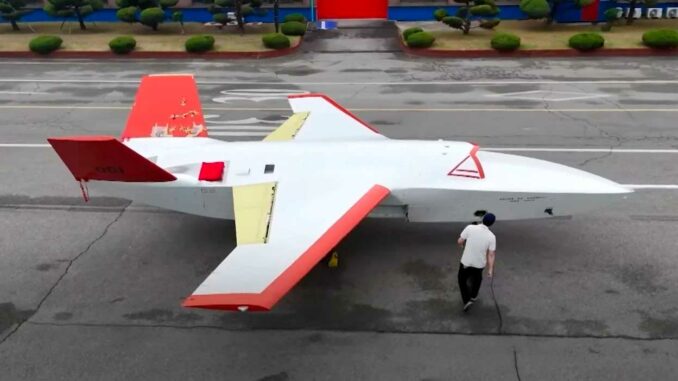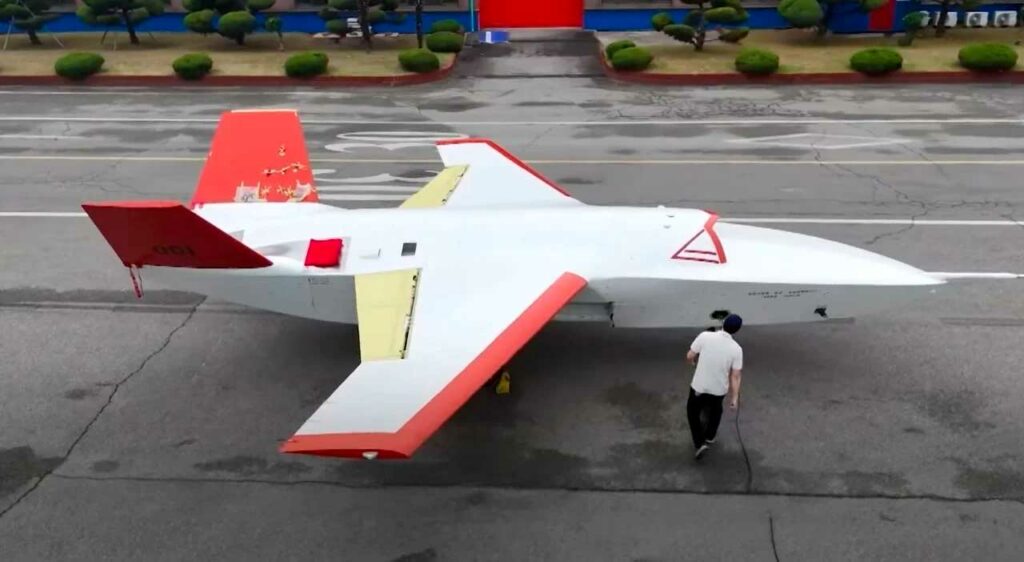
South Korea is developing an autonomous stealth drone to accompany its KF-21 fighter jet. The aim is to strengthen its air superiority with AI.
South Korea is investing heavily in an autonomous stealth drone designed to operate in tandem with its new KF-21 Boramae fighter jet. The program, dubbed Loyal Wingman, relies on artificial intelligence to carry out reconnaissance, attack, and air defense suppression missions. In a recent simulation, these drones carried out coordinated strikes in direct interaction with the KF-21 pilot. Ground tests are underway, with a first flight scheduled for 2025 and entry into service targeted for 2030. The project reflects Seoul’s clear desire to automate its air combat capabilities while reducing human risk, against a backdrop of growing tensions in Northeast Asia.
A strategic program for South Korea’s air doctrine
Since 2021, South Korea has been developing a stealth combat drone system designed to operate in close coordination with a manned fighter jet. The goal is to adopt a combat structure known as “manned-unmanned teaming” (MMT), in which a pilot coordinates the actions of several drones in flight, each of which can carry out offensive, defensive, or intelligence missions. This principle is based on partially decentralized control, in which humans retain strategic control but delegate tactical execution to onboard artificial intelligence.
In this configuration, the drone becomes a force multiplier: it acts as a scout, interceptor, or SEAD fighter (Suppression of Enemy Air Defenses). Thanks to their stealthy design and swarm programming, these platforms can precede the main fighter’s entry into a contested area. In the event of a threat, the drones take the initial risks, thereby reducing the exposure of the manned aircraft. This is in line with a global trend, already visible with the US Skyborg, the Australian MQ-28 Ghost Bat and the European Remote Carrier.
The decision to integrate artificial intelligence into these drones reflects a profound shift in South Korean doctrine. Seoul believes that automating tactical management of airspace will compensate for the digital imbalance with its neighbors. In 2023, China had nearly 1,900 fighter jets (source: Global Firepower), compared to more than 400 for South Korea. The solution envisaged is therefore not to match numbers, but to achieve algorithmic efficiency. The simulation released by KAI (Korea Aerospace Industries) shows a KF-21 pilot capable of giving a single command (“strike”) to several drones, which then carry out precision strikes against enemy radars.
The role of the KF-21 Boramae in the offensive system
The KF-21 Boramae, developed by KAI in partnership with Indonesia, is South Korea’s first locally designed supersonic fighter jet. It is intended to replace the aging F-4 Phantom and F-5 aircraft, while offering an alternative to the American F-35 for export. The Boramae has a speed of Mach 1.8, a range of approximately 2,900 km, and a payload capacity of 7.7 tons of weapons. Its AESA radar, digital cockpit, and open architecture make it a 4.5th generation aircraft, close to the standards of the Rafale or Eurofighter.
By adding associated drone capabilities, South Korea is increasing the flexibility of the KF-21. It is no longer limited to direct missions: it can now coordinate expanded air operations, including electronic warfare, deep penetration, and SAM neutralization. This distributed architecture places the Boramae in a new category of platforms capable of multi-domain operations.
From an industrial standpoint, this drone-fighter tandem enhances the export offering. The KF-21 program is explicitly targeting foreign markets, particularly in Southeast Asia, the Middle East, and potentially South America. The development of a “loyal wingman” module further enhances its appeal. The drone is scheduled to enter service around 2030, which is a favorable window for several fleet renewals. In the coming years, countries such as Malaysia, the Philippines, and Peru could acquire the drone, provided that the tandem is more affordable than American or European solutions.

A stealth drone piloted by artificial intelligence
The drone presented by KAI is still at the demonstrator stage, but it already has several specific features. It is equipped with a stealth fuselage with low radar cross-section, an electro-optical payload, and flight controls that have been tested on the ground. The prototype shown in the video broadcast on SBS (Korean national channel) shows a white-painted airframe with red markings for wind tunnel testing and flow verification.
The concept is based on a semi-autonomous drone capable of operating in swarms or individually, with a secure data link to the main aircraft. The drones receive mission orders, identify targets using their sensors, and then carry out strikes or jamming actions. The on-board sensors are optimized for electromagnetic and infrared detection, and their fusion enables localized decision-making autonomy. This means that even if the link with the pilot is lost, the drones can continue their mission according to pre-programmed parameters.
The takeoff weight has not yet been made public, but the expected performance is in line with that of the nEUROn or XQ-58 Valkyrie, i.e., a weight of around 3 to 6 tons, with a range of approximately 1,500 km. These drones are designed to operate on the front line at high speed and carry guided munitions or jammers. If necessary, they can also be used as radar decoys, thereby increasing the penetration capability of the airborne device in contested airspace.
An ambitious but realistic industrial schedule
The schedule announced by KAI and the South Korean Ministry of Defense calls for a first flight of the stealth drone by the end of 2025. Joint tests with the KF-21 would be conducted as early as 2026, with full operational qualification targeted for 2027. Effective entry into service with the South Korean armed forces is envisaged around 2030. To meet this deadline, technical milestones are already underway: wind tunnel tests, flight control tests, and development of the AI interface with pilots. The assembly line would be based at KAI’s main site in Sacheon.
This schedule coincides with the deadlines of several competing countries. The United States plans to bring its Collaborative Combat Aircraft (CCA) program into operational service around 2030. Europe is developing its own projects under the SCAF and Tempest programs, but these are still in the pre-industrial phase. By integrating these technologies more quickly, South Korea could position itself as a credible alternative supplier, particularly for armies seeking rapid access to MMT solutions.
This program could also enable Seoul to reduce its technological dependence on the United States. Although the F-35 remains a pillar of South Korea’s deterrence (40 units delivered to date), South Korea aims to expand its strategic autonomy. A 100% locally produced drone, combined with a national fighter jet, represents a sovereign tool for airspace control, without any restrictions on use imposed by a foreign partner. Ultimately, this could change strategic export choices, particularly to non-aligned countries.
Operational and geopolitical consequences of the project
The integration of a stealth drone into the ROKAF doctrine significantly alters regional tactical balances. Faced with an unstable North Korea and in a context of constant tension with Beijing, the use of autonomous platforms allows South Korea to expand its active deterrence capabilities while limiting the exposure of its pilots.
This technological change also has consequences for alliances. If Seoul masters its own drone-fighter system, it can offer joint exercises, pilot training, and industrial cooperation with second-tier partners. This capability increases its regional influence, particularly with countries that have a small air force but wish to integrate disruptive technologies without depending on the United States.
Finally, the Korean project is forcing other powers to accelerate their efforts. China, which is testing the J-35, has not yet presented a finished loyal wingman system. Russia, which is experiencing industrial difficulties, has no clear timetable for an equivalent operational drone. If South Korea achieves its objectives in 2027, it will become the first non-NATO country to have an operational MMT architecture, which represents a major shift in the global air power balance.
War Wings Daily is an independant magazine.